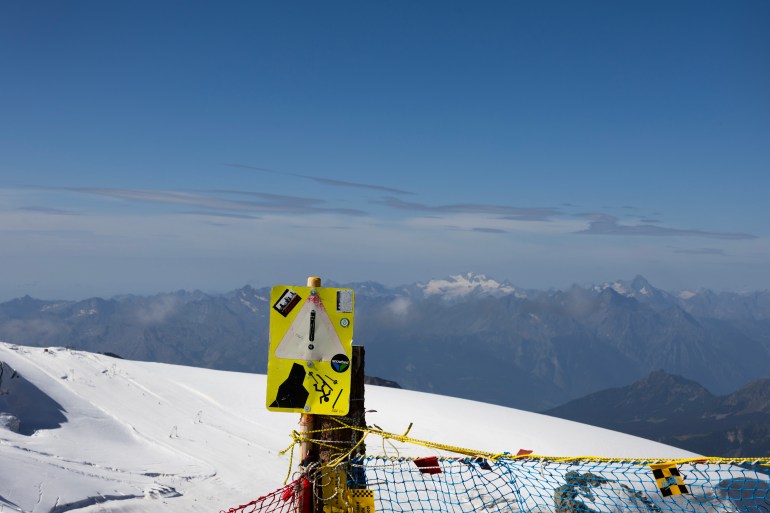Switzerland and Italy redrew their shared border in the Alps last week, forced by melting glaciers that, along with vast snowfields, define large sections of the territorial boundary between the Central European neighbours.
In May 2023, an agreement to change the border was drawn up between Switzerland and Italy. That agreement was ratified by Switzerland last week and awaits approval from Italy. The border change will happen under the Matterhorn mountain, which straddles the two countries.
Unlike most border changes that are often the byproduct of wars or conflicts, there is no dispute between Italy and Switzerland over this shift. However, the trigger for the change is a worry for both: climate change, which has resulted in significant glacial melt since at least the 1970s.
So how are melting glaciers changing the Swiss-Italian border, where does the boundary between the two shift, and is Europe witnessing melting glaciers more generally?
How and why is the Swiss-Italian border shifting?
“In the high mountains, significant sections of the Italian-Swiss border are determined by the watershed, represented by the crest line of glaciers, snowfields and perpetual snow,” the Swiss government explained in a statement on September 27. “However, with the melting of the glaciers, these natural elements evolve and redefine the national border when it is defined dynamically.”
Simply put, the ridge that runs along the highest points on the glacier that sits on the Matterhorn serves as the natural border between Italy and Switzerland. It is determined as the line along which any glacial melt could fall on either side.
As the glacier has melted, the highest points – and so the ridge joining them – have moved a little further into Italian territory. In other words, the Swiss will gain a bit of territory under the new border agreement.

Is this the only instance of melting glaciers shifting borders?
No. This is not just an issue between Italy and Switzerland. A new border agreement was signed between Italy and Austria in 2006.
In their book, A Moving Border: Alpine Cartographies of Climate Change, Marco Ferrari, Elisa Pasqual and Andrea Bagnato examined how melting glaciers and shifting watersheds are affecting the borders between Italy, Austria and Switzerland.
Explaining their findings in a 2022 interview with Vox, Ferrari said many of the analysts responsible for mapping and surveying the border boundaries had noticed the glacier was melting and snow was not being replaced. The constant melting of the glacier would slowly affect the natural shape of the border.
Does the changed border affect anything?
Switzerland and neighbouring parts of Italy rely heavily on tourism linked to skiing and other Alpine sports for their economy. In fact, the economies of the bordering regions are often interlinked.
Ski resorts such as Zermatt in Switzerland attract hundreds of thousands of tourists every season, but access ski terrain which is shared with Italian resorts.
Melting glaciers affect both. But maintaining glaciers and ensuring their health is the responsibility of the country where it lies – and clear boundaries are critical for Italy and Switzerland to know which part of each border glacier they are respectively responsible for.
Still, even with a shifting border, the neighbours will need to collaborate. Avalanches, for instance, do not respect borders – they can begin in one country and end in another. This can complicate issues when it comes to footing the bill for damage or lost lives.
In April this year, three people were killed in an avalanche slide near Zermatt. Climate experts attributed the sudden avalanche to glacial melting caused by temperature fluctuations which have created weakened layers in the snow pack.
On July 3, 2022, 11 climbers lost their lives on the Marmolada summit, the highest mountain in the Dolomites, due to a rock and glacier fall. A chunk of the glacier collapsed, sending ice, rock, and snow onto the climbers.
How have European glaciers been affected by climate change?
According to a recent report from the Swiss Academy of Sciences, Swiss glaciers lost 4 percent of their volume in 2023 with the largest decline at 6 percent in 2022. That is a 10 percent cumulative loss of their ice volume over the past two years with further losses anticipated in the foreseeable future.
That volume loss is the same as the amount of ice lost between 1960 and 1990. Some areas are experiencing an average ice melt of 3 metres (roughly 10 feet) over a period of two years from 2022 to 2023, recorded at altitudes above 3,200 metres (about 10,500 feet).
According to the European State of the Climate 2023 study, compiled by the Copernicus Climate Change Service (C3S) and the World Meteorological Organization (WMO), Europe is close to the Arctic whose polar regions are more susceptible to intense weather events. Furthermore, oceanic and atmospheric currents around Europe are warmer.
Extreme glacial melt has several knock-on effects besides avalanches.
As glaciers further lose their ice and snow coverage, this reduces their capacity to reflect sunlight. This lowered “albedo effect” causes additional warming, which in turn speeds up the melting process. Consequently, a self-reinforcing cycle emerges, where the initial melting triggers further ice loss, perpetuating and intensifying the glacial decline.
The 2023 report also states the following:
- Year 2023 was the second-warmest on record for Europe, at 1.02–1.12C (1.8-2F) above average.
- The three warmest years on record for Europe have all occurred since 2020, and the 10 warmest since 2007.
- Temperatures in Europe were above average for 11 months of 2023 and September was the warmest on record.
- Winter and autumn, 2023, were both the second-warmest on record.
Can the melting of glaciers be reversed or stopped?
According to the European Geosciences Union, glaciers will lose half their ice by 2050 even if the planet warms less than 2C (3.6F) above pre-industrial levels.
The 2015 Paris Agreement, a landmark international treaty aimed at addressing climate change and adopted by 196 countries, agreed that limiting global warming to 1.5C (2.7F) above pre-industrial levels should be the target to slow down further glacial melt and avoid the potentially catastrophic effects of climate change.
More innovative solutions to address melting glaciers in particular include Geotextiles – white fabric placed over areas of a glacier to reflect the sun away and insulate the glacier.
The Seabed Curtain project is a programme to build a massive curtain anchored to the seabed along the Antarctic coast that would restrict the flow of warm water to prevent further melting of glaciers there.
According to the Arctic Centre at the University of Lapland in Finland, the cost of such a project could be $40bn to $80bn along with $1bn to $2bn annually in maintenance costs.










More Stories
VIDEO: Porch pirate takes off on bike with packages
Outdoor retailer to leave its doors closed on Black Friday
Proctor’s Garden: Juggling three seasons at once